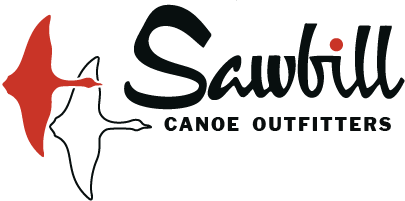5/25/25 – Two weeks ago today, I set out on my first canoe trip of the season with one of my best friends, Tess! She had never been to the BWCA before, let alone any part of northern Minnesota. It was so wonderful to share this place with her and to spend some time in the woods before starting work again for my second season. Without further ado, here is my trip report from our time on the West Little Saganaga loop!
We launched from Sawbill the morning of May 11th with the plan to make it to Phoebe for the night. We were taking out a Northstar Pearl canoe, a new model for Sawbill this season. The Pearl is a shorter model than our other tandem canoes and can be paddled solo as well. We set off on Sawbill with a short paddle over to Alton, where we encountered some stronger headwinds. It was a bit of a battle to get across the lake, and it was definitely throwing Tess into the deep end, but it was good practice for both of us, and a good way to fine-tune how we wanted to pack the canoe. We then portaged through to Beth and Grace, opting to skip over Ella. After paddling and portaging through some smaller river sections, we made it to Pheobe and set up camp on the site on the lake’s northern shore. Before paddling out, we got a few tips from fellow crew members about this route, and this site was one of those recommendations. We were able to spot it quite quickly because of the large white pine in the middle of the site that stuck out of the tree line, which is mostly covered in cedars and evergreens.
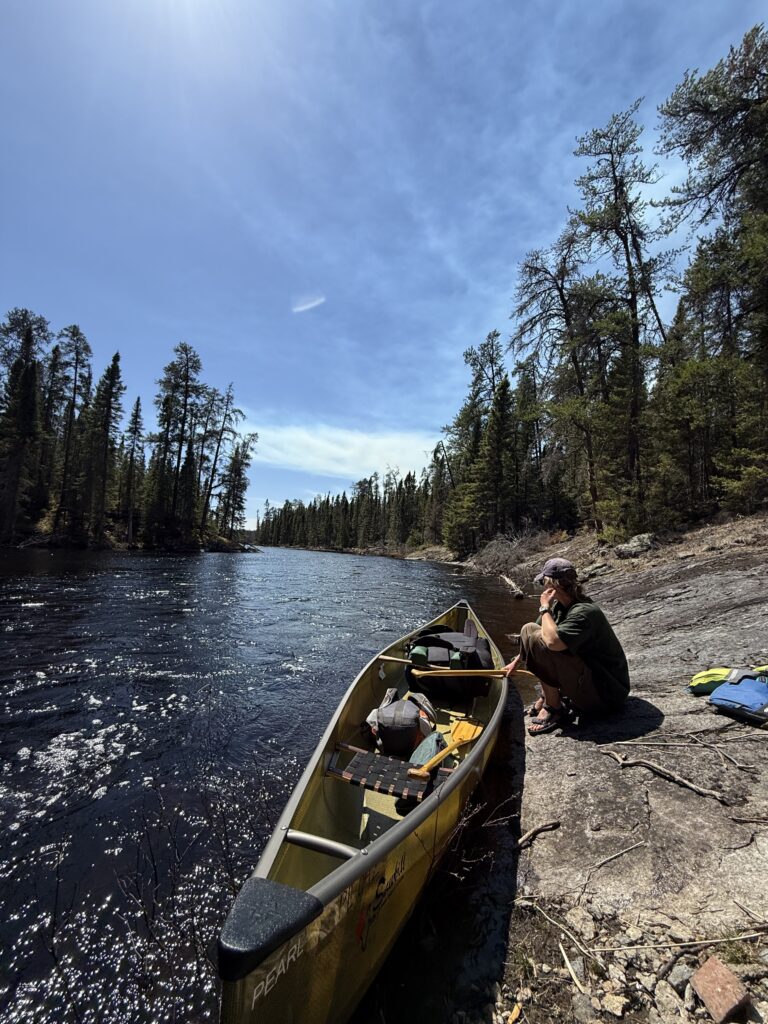
We were very lucky on this trip to have beautifully warm and sunny weather the whole week, and we took advantage of this, having gotten to camp quite early on this first night. We both went for a swim, set up camp, and spent some time sitting in the sun, and before we knew it, it was time for dinner! We knew this first night out was the full moon, so we stayed up to wait for it to poke out from the horizon. We scrambled down to the shore and were met with a beautiful view of the moon, glowing bright and golden.
The next day, we set out planning to camp on Koma. We were having a smooth morning of paddling, reflecting on the previous day and what was ahead of us. This was the first time we had seen people since we had launched from Sawbill. There were a few groups on their way out, and another group sitting on the shore of their campsite. Conditions were calm, there were beautiful blue skies, and the sun was out. A perfect morning to paddle.
We hit a bit of a snafu on the channel coming out of Knight Lake, there is a rocky section that had a faster-moving current. We didn’t plan to stop as soon as we should and were sucked into the current. After a few minutes of scrambling, recovering a few pieces of gear, and a handful of new bruises, we were back on our way, paddling up the channel. In situations like these, it is always best practice to give yourself ample time to make a game plan, and if there is no safe way to paddle through, unload your canoe (especially if it is Kevlar) and find a way to traverse around the area instead.
The rest of our paddling for the day was through many other narrow lakes and river sections, and we used the utmost caution to make sure we were avoiding dams, currents, and other things that could harm the canoe, and ultimately ourselves! One of the interesting things about the tofte district I have found is the amount of change caused by the beavers in this area, and paddling through this section was very clear to see, and so fascinating.
We continued to paddle and portage, switching off who was carrying our pack and canoe, and eventually made it to Koma to set up camp for the night. We were both quite tired after a longer day of travel, and spent some time hanging out in our hammock before making dinner. On this night, we saw the first signs of the wildfires burning in Brimson, the sun was a bright orange orb as it set on the horizon, and the sky looked very ominous. We knew these were tell-tale signs of a fire, but without phone service, we were unsure of where they were burning. It has been a very dry spring, and with a few weeks of intense sun and heat that is quite abnormal for this time of year, the BWCA is very dry and at high risk for wildfires currently. Please practice the utmost caution if you do decide to have a fire.
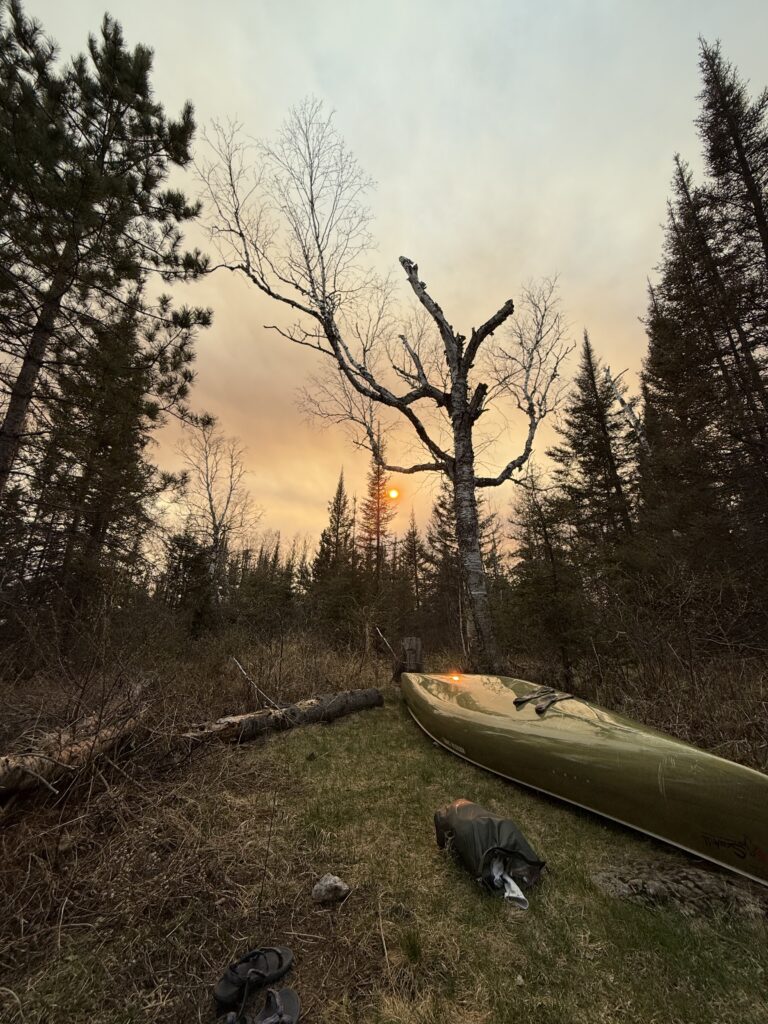
The next morning, it was finally time to head north to Little Saganaga. I have heard how beautiful this lake is over the years and was very excited to finally spend some time there. This third day had a good balance between paddling and portaging, with the portages being a bit shorter across the board. In general, we found the conditions of most portages throughout this trip to be as expected. There were a handful of down trees, which is normal, especially in the early season. They were all able to be climbed over or walked around, but we did pack a saw just in case. The dry conditions also helped to lessen the amount of mud overall.
We opted not to drop down into Fishdance, an addition to this route that is strongly recommended if you have the time. There are pictographs on the southern part of this lake that are really worth checking out if you are in the area. Sadly, we did not have the time on this trip, so we paddled on, through the Kawishiwi River, and eventually onto Little Saganaga. We were blessed again with beautiful weather, sunny and warm. It was really cool to feel how much the temperatures of the lakes differed depending on their size. Little Saganaga is a larger lake with some beautiful islands and huge rocks on the shoreline, and the water was colder than the lakes we had state don previously due to its size. We wound up staying on the site at the point on the southern shore. This was one of the best sites I have stayed on in the BWCA, and we were grateful to roll into camp in the early afternoon so we had time to enjoy it. We swam, read our books, sat in the sun, and spent some good quality time together appreciating the beauty of this protected wilderness.
After a quick dinner, we swam yet again as we were roasting in the heat. This site is very open and raised off the water, making it very exposed to the sun. A quick dip in the freezing cold water helped immensely. We had a beautiful view of the sunset, which was still showing signs of fires somewhere. Eventually, it was time to head to bed. Tess opted to sleep in a hammock throughout our trip, and I had been sleeping in a tent. But this night I decided to cowboy camp. We both fell asleep looking at the stars and listening to a few loons calling to each other on the lake. These calm nights are the ones I often call to mind in the dead of winter when everything is cold and covered in snow.
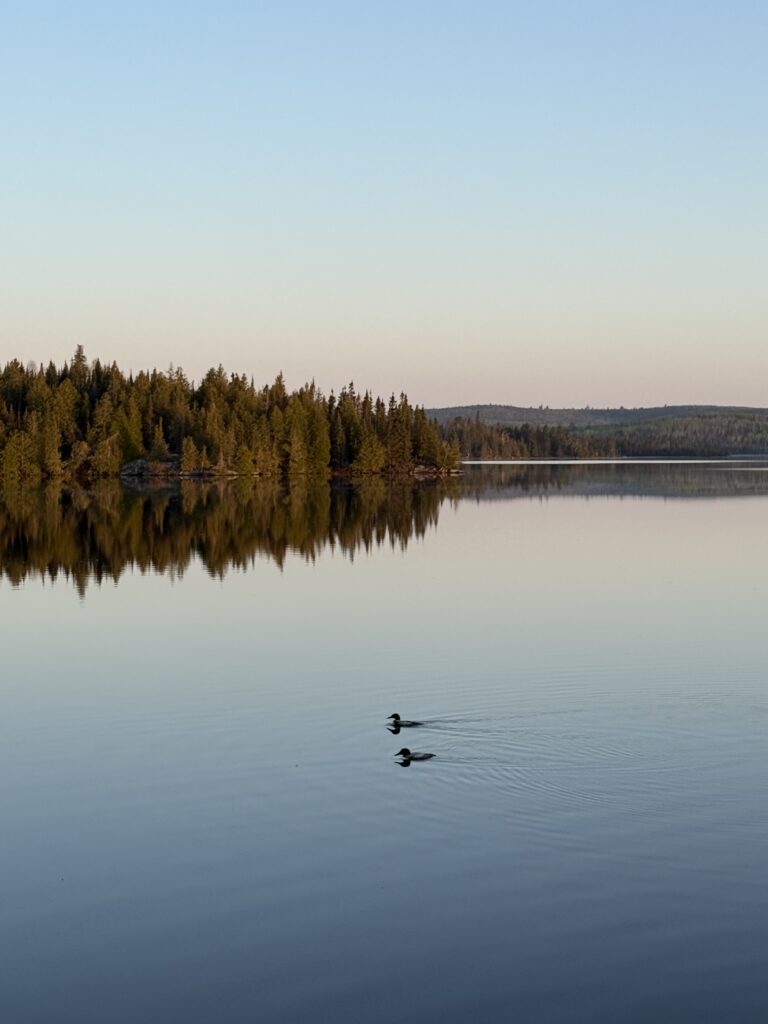
We had planned for a long journey on our 4th day out, so we awoke with the sunrise. I sat on one of the large rocks, looking at the shore before getting ready for the day, and watched two loons float by. After eating breakfast and packing up camp, we were on the water by 7:45. The original plan was to stay on Masaba for the night, but we wanted to exit the wilderness earlier on Thursday, so the goal was to cover more ground than that. At this point in the trip, we were a well-oiled machine when it came to portaging, unloading, and loading the canoe. There were a few portages that it took us a little bit to find, but it was smooth sailing most of the way. We were on Mesaba by lunchtime and decided to stop for lunch at the river right along the portage into Hug Lake. After dunking in the deeper pools of the stream and having a quick lunch, we were off again, still unsure of where exactly we wanted to set up camp for the night.
We stopped and looked at the plane crash on Zeenith that happened in 1946, which rests on the northern shore of the lake. We checked out the site on Zeenth, but with how early it was still in the day, we decided to keep moving. We tackled the infamous mile and a half long portage onto Lujenida, which I think gets a worse rap than it deserves. It is quite long as far as portages go, but there are some beautiful views along the way. After paddling and portaging a little bit more, we finally arrived at camp after our longest day. We set up camp on the second site on Kelso, which has some beautiful rocks leading into the lake, an underrated site for sure. We swam again, filtered our water for the night, and eventually made our last dinner. We watched the sun set and then tucked into bed.
We had a leisurely morning on our last day, enjoying the view with breakfast. It started to rain a little bit, so we quickly packed up camp and hit the water, heading back to Sawbill. Tess steered the canoe on Kelso, which was a great time to practice some new skills! After paddling down Sawbill, we had officially exited the wilderness, meaning it was time to dry out and clean up our gear. We headed into Grand Marais for an obligatory post-trip dinner at the Angry Trout and reflected on what an amazing time we had had together.
I feel so lucky for the beautiful weather we had; it truly felt like August. These early-season trips can be hard to plan weather-wise, and these conditions were the exact opposite of what we were expecting. Because of the warmer weather, we were seeing signs of greenup through our trip. We could see the birches on the shoreline getting their leaves, and on each portage, new plants were appearing, showing clear signs of spring!
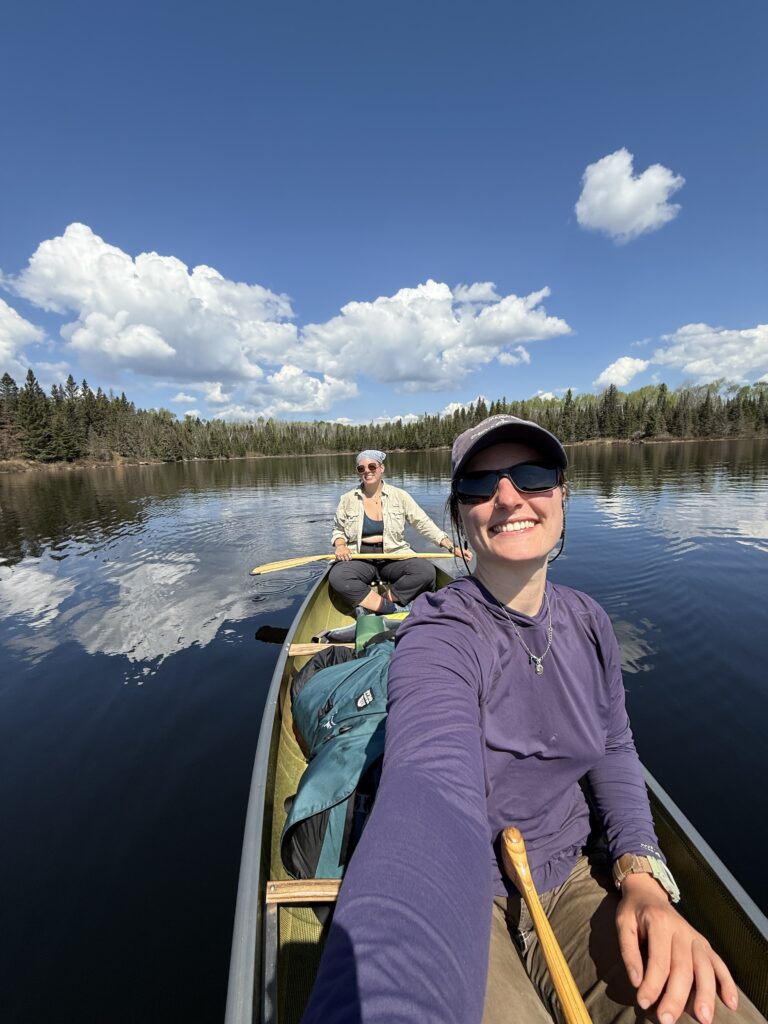
Throughout this trip, I was consistently reminded of how magical it is to share these experiences with someone. After a busy school year, Tess and I both need the time to decompress and reground ourselves, and this wilderness is always the perfect medicine. One night in camp, Tess shared this quote with me from the book she was reading, Boys in the Boat, and I thought about it often throughout our trip. “It is hard to make the boat go as fast as you want to. The enemy, of course, is resistance of the water, as you have to displace the amount of water equal to the weight of the men and equipment, but that very water is what supports you and that very enemy is your friend. So is life: the very problems you must overcome also support you and make you stronger in overcoming them.”
Get outside, spend some time with the trees and a friend, and thank you for reading about our trip!
– Indie
